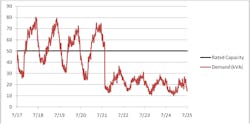You don’t need to collect data on the number of times data analytics is discussed throughout our industry to know that this has become a red-hot topic – and with good reason. In the era of the smart grid, the amount of data that’s now being amassed is colossal – and growing. It’s data analytics – the process of analyzing data to identify significant, useful and otherwise interesting trends and patterns – that will enable your utility to transform this vast volume of information into profitable business insights.
What’s driving the boom in data? Why is it becoming more urgent to unlock its value? And how can your utility approach data analytics not only from a tactical, day-to-day operational perspective, but also from a more long-term, strategic vantage point? A quick look at these questions and their answers follows.
Challenge or Opportunity?
Over the last few decades, changes in technology, market and regulatory forces have rattled a utility industry accustomed to slow, predictable changes. A few of the major trends include:
-
One data point vs. thousands: For each meter today, we have the ability to collect thousands of data elements per month with multiple types of measurements and events. This shift was enabled by improvements in communications and metering, and supported by plummeting costs for storage and processing power.
-
Increased competition: Improved technology and regulatory mandates have introduced solar and wind generation across widely distributed geographical areas. Results from increased competition range from requirements to accept and compensate alternative energy suppliers to completely eliminating vertical utilities in some markets.
-
Shifting fuel sources: There is a growing dependence on natural gas for generation due to increased production and lower costs. Meanwhile, large coal and nuclear plants are closing in response to regulatory and financial pressures.
-
Electric vehicles (EVs): A forecasted surge in the number of EVs and the associated increase in charging requirements threaten to radically alter historical demand patterns.
The cumulative effect on utilities because of these changes is immense. More supply sources (many with no means of central control) coupled with increased demand volatility will complicate grid management. Utilities will need to improve existing capabilities and introduce new disciplines to predict future supply and infrastructure needs. To meet the growing expectations of consumers, utilities will need to deliver a broader range of information, faster service and near instantaneous status updates.
The Analytical Response: Tactical vs. Strategic
To better respond to the short term challenges as well as to improve long-term competitiveness, utilities are investigating data analytics.
The analytic applications implemented and publicly discussed to date have tended to focus on a relatively narrow range of functions. For example, tactical analytic systems have been deployed that improve upon existing processes and operations, such as:
-
Identify likely source of outages: Utilities receive “last gasp” outage notifications from smart meters. In order to quickly identify most likely points of failures, these notifications are mapped against the distribution infrastructure.
-
Identify failing meters or grid components: Utilities are monitoring the pattern of meter health events, reported consumption or communications success to identify devices that may be failing. The devices can be targeted for in-depth evaluation via a field visit.
Other applications have been deployed that are focused on longer-term issues or bringing new predictive capabilities to the utility. Examples of these more strategic systems include:
-
Transformer monitoring: Used to predict likely transformer failures as well as more fully utilize transformer assets, transformer monitoring programs compare the loading of a transformer over time with defined operational parameters. As a result, utilities can target transformers for replacement before incurring unplanned outages. In addition, they can more fully utilize transformer assets, thus reducing infrastructure costs.
-
Theft and leak detection: By correlating tamper events with usage patterns and comparing usage between similar residences or facilities, utilities can identify potential energy theft. Analysis of usage patterns is also being used to identify gas diversion and water leaks.
-
Conservation voltage reduction: With monitors and control equipment to ensure that line voltage is maintained within operational targets, utilities can lower distribution line voltage to better manage demand and energy consumption.
-
Forecasting: AMI enables the capture of interval data across a much broader portion of customers. When merged with other data sources such as weather and demographic information, such detailed historical data will fine-tune forecast accuracy for future infrastructure and energy supply needs.
-
Marketing: In the face of more competitive markets and pressure from regulators, most utilities are looking for ways to improve customer satisfaction. By marrying meter data with demographic and financial data, analytics can help determine which customers are best suited for, and most likely to adopt, new programs.
Laying the Foundation
At this early stage of introducing analytics to address business issues, what should you do to prepare the foundation for analytic applications?
-
Develop the people resources to implement analytics effectively. Most utilities will use a combination of strategies, such as training existing staff with deep utility domain knowledge, bringing in experts from other industries and the academic world, and seeking out vendors and consultants with proven expertise.
-
Put systems in place to capture and store the data that will yield the greatest benefit. Most initial analytic applications incorporate AMI data, leveraging the ability of AMI systems to capture register data at 5- or 15-minute intervals, as well as other data such as power quality measurements. Adding GIS location data and grid relationships greatly magnifies the potential usefulness of the data. Some utilities are adding sub-metering for tenants in commercial or residential facilities, individual equipment components such as heating or refrigeration, or customer generation equipment.
-
Ensure the quality of the data. While utilities have systems and processes in place to insure reliable data for billing, validation and estimation processes might need to be established for the additional meter data being captured.
Thinking Bigger about Data Analytics
A Word about Platforms
As the volume and type of meter data being collected by operational systems such as AMI head ends and MDM systems have increased, utilities have understandably looked for help to unlock the potential of this data. Some organizations expect that existing operational systems, especially the MDMS (as the meter data system of record), will also handle the full task of analyzing and reporting on all of the meter data.
This approach is not recommended. Combining operational and strategic analytics on the same system can compromise system performance for both activities. Taxing the system with processing-intensive data analysis which may be scheduled on an ad hoc basis will impact with the critical nature and timeframe for the “meter to cash” processing. In addition, the data structures implemented for operational systems such as an MDMS are not optimal for data analysis.
While we do expect MDMS systems to address additional predefined “lightweight” analytics in the future, and it is certainly possible to oversize the MDMS infrastructure to address the demands related to analytics beyond the operational workloads, we recommend a separate, dedicated platform be considered for a full implementation of analytics. Defining the structure of this platform is beyond the scope of this article, but it should be noted that “big data” analytic platforms in many fields are increasingly supplementing or supplanting traditional data base management technologies with other technologies including NoSQL databases such as Apache Hadoop to address the technical and cost challenges of processing unstructured data and very large data sets.
Toronto Hydro: Analytics at Work
Toronto Hydro-Electric System Limited’s (Toronto Hydro) distribution grid intelligence quotient is in the midst of a major boost. Like many electricity utilities across the globe, the company is working to develop a smart, continually evolving electricity network to meet the needs of its modern customers. The Asset Management division of the utility has been exploring the benefits of transformer monitors since 2009 as part of an overall grid modernization strategy.
A Crystal Ball, of Sorts
Toronto Hydro is using transformer monitor technology to unlock new information about transformer load management. The devices let the utility see which transformers are overloaded and calculates equipment end of life. In turn, this allows Toronto Hydro to upgrade equipment before it fails and helps to improve service reliability.
Transformer Monitors Can Lead to Fewer Outages of Shorter Duration
A typical outage period for reactive overhead transformer replacement work is approximately six to 10 hours. Thanks to the transformer monitor deployment, in the summer of 2011, Toronto Hydro identified 12 overloaded transformers and performed proactive upgrades and redistributed secondary connections to alleviate overloading. Through this work alone, the utility saved, and customers were spared, approximately 100,000 outage minutes.
Lightening the Load on Overburdened Transformers
Transformer monitor analytics helped Toronto Hydro identify the overloaded transformer depicted in the graph (below). When the utility learned that it was operating at almost 80 per cent overcapacity, Toronto Hydro took action and installed a new transformer on the same secondary bus on July 21st. This reduced the load on the original transformer by almost 50 percent.
Figure 1 – Load profile of TX#1. New transformer added to same secondary bus eliminates transformer overload
As we work to renew our electricity grid, we’re incorporating smarter technologies to meet the needs of today’s customers. Transformer monitors allow Toronto Hydro to measure the behavior and performance of the network, and are ultimately enhancing our service reliability.
- Richard Ford, Manager, Grid Solutions, Toronto Hydro
Smart Grid Analytics at Work
The City of Kings Mountain, NC, is succeeding with smart grid analytics through a partnership with Leidos and Elster. Early successes, like in much of the industry, have centered on proactive problem identification. Analytics focused on outages, voltage alarms, tamper and water leaks have helped improve customer service, reliability and service quality, all without increasing costs or rates.
Beyond the basics, the City of Kings Mountain has started to benefit from more advanced analytics across the community. The utility has been aggressively developing and delivering analytical capabilities, including web-based tools to view high-fidelity reports on energy, demand and power factors, to their commercial and industrial clients in order to develop buy-in and engagement. The utility has also been able to leverage these investments to win new commercial and industrial customers who have a choice of which utility they will use.
The realized economic expansion includes the construction of more than 600,000 square feet of Fortune 500® company data center facilities, and the city is the chosen location of the proposed Catawba Casino. During the casino’s selection processes, the utility highlighted its successful smart grid implementation in support of their progressive capabilities. The $600 million casino plans to move forward upon legislative approval and is anticipated to result in 5,000 new jobs in the community. The utility is winning new clients and revenues; the city is expanding its revenue and tax base; and the community is enjoying economic expansion, in part, due to smart grid analytics.
About the Author
He has been responsible for product management, development and delivery of industrial load control, real time pricing, complex billing and meter data management solutions.
About Elster Solutions
From smart meters and other grid sensors, to advanced metering infrastructure (AMI), meter data management (MDM), network communications, data analytics and pre-integrated, partner-based solutions for sophisticated grid power management, Elster’s solutions unlock the data stored in electric, gas and water meters. By transforming meter data into meaningful grid performance information, Elster helps utilities and their customers improve system reliability, enhance operational efficiency, enhance customer service and reduce their carbon footprint.
Content brought to you by: Elster




